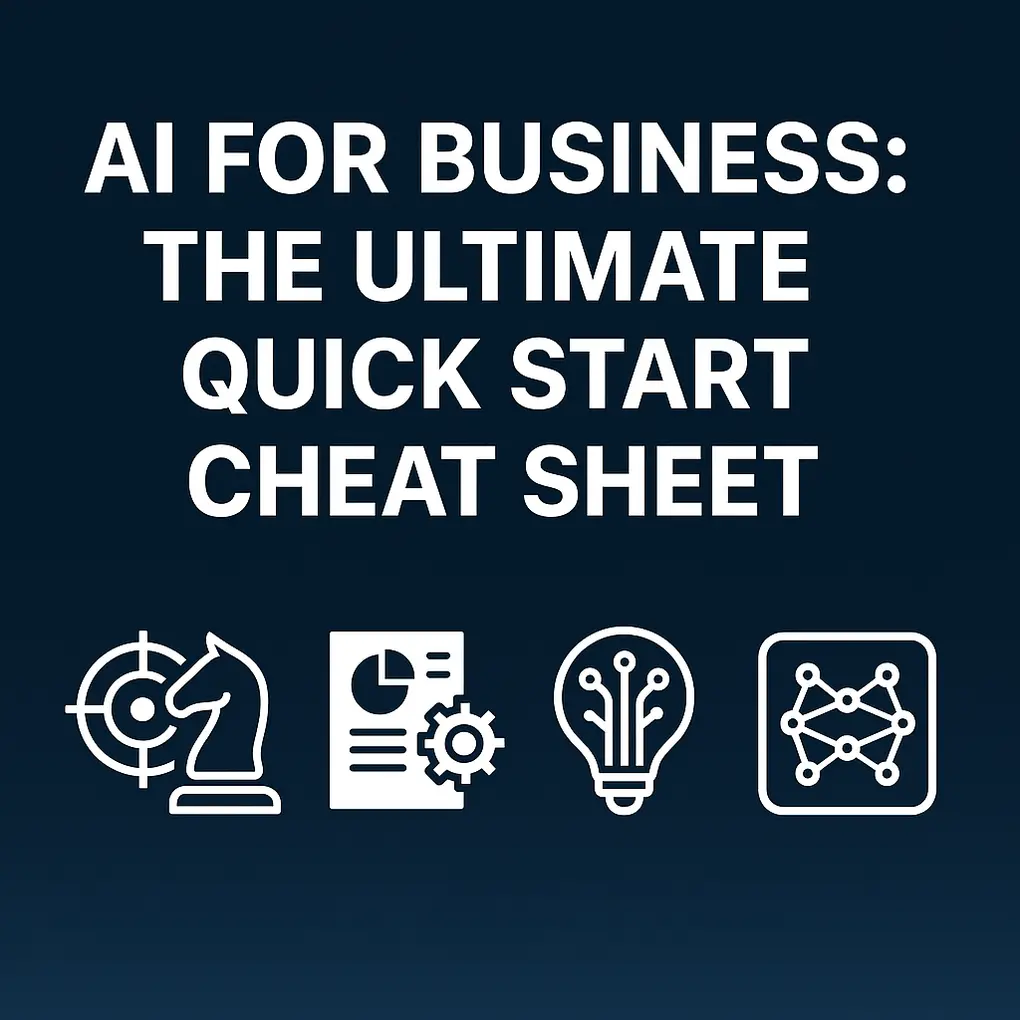🧭 Introduction – From Curiosity to Competence
Artificial Intelligence is no longer an experiment, it’s a business necessity. But while most organisations rush to adopt “something with AI,” very few have a clear strategy, cultural readiness, or understanding of what kind of AI to implement.
That’s where this guide comes in.
This all-in-one guide brings together the core lessons from six foundational DataCamp courses:
- 🧭 AI Strategy
- 🏗️ Implementing AI Solutions
- 🧠 Generative AI for Business
- 💬 Large Language Models (LLMs) Concepts
- 🤖 Introduction to AI Agents
- ⚙️ Building Scalable Agentic Systems.
It’s built as a progressive learning path, from strategy to real-world AI agents, so you can understand, plan, and deploy AI that truly adds business value. Think of it as your AI roadmap: each section builds upon the previous one, transforming your understanding from strategy → implementation → intelligent automation.
🎯 Goal: By the end, you’ll know how to design, implement, and scale AI in your business responsibly and effectively.
💡 Use this cheat sheet as a companion to our Best AI for Business Online Courses to Get You Started .
🧩 Rethinking Strategy: Why Every Business Needs an AI Blueprint
AI success begins long before coding, it starts with strategy.
According to DataCamp’s AI Strategy course, a well-designed AI initiative connects business goals, data readiness, people, and technology into one framework.
📋 How to Implement AI in Business
1️⃣ Define the Vision: Crafting Your AI Strategy
Key lesson: Strategy comes before software.
AI isn’t a plug-and-play fix. It’s a framework for transformation grounded in leadership, data, people, Customer Relationship Management (CRM), and ethics.
🧱 The Four Pillars of a Winning AI Strategy
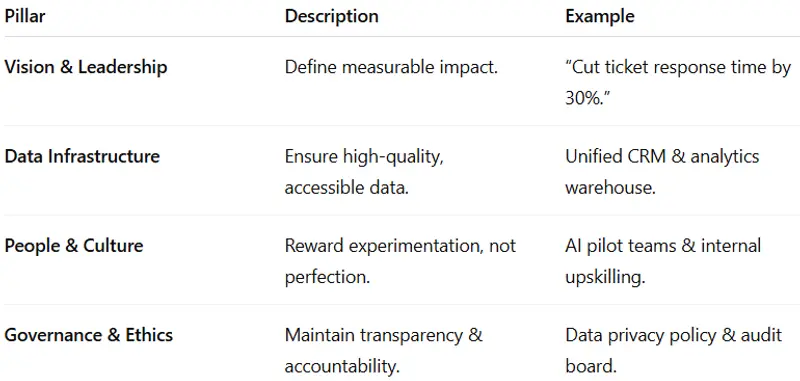
🎯 Set SMART Goals Early
Every successful AI strategy begins with SMART goals - objectives that are Specific, Measurable, Achievable, Relevant, and Time-bound. SMART planning keeps your AI initiatives focused, testable, and outcome-driven.
- Specific: Define one clear goal, e.g., “Automate 25% of customer service interactions.”
- Measurable: Establish metrics to track performance and Return on Investment (ROI).
- Achievable: Match ambitions with data availability and team skill.
- Relevant: Align every project with your business priorities.
- Time-bound: Set a defined timeline, e.g., “in six months.”
💡 Why it matters: SMART goals turn abstract AI ideas into measurable impact, helping leaders communicate progress and secure executive buy-in.
💬Lesson
Start small, track ROI, and communicate early wins to build organisation-wide trust.
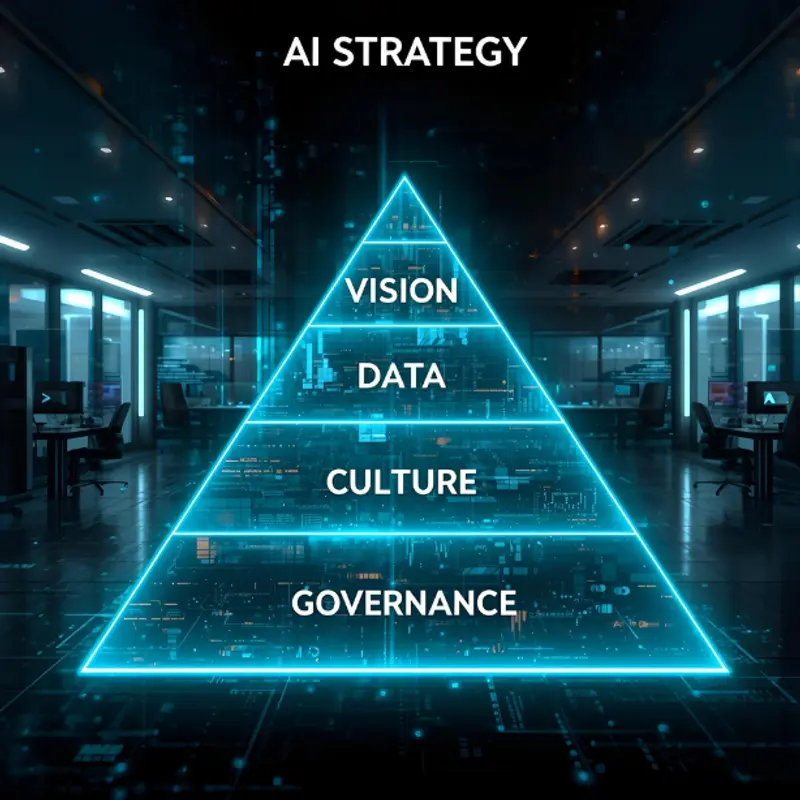
2️⃣ Implementation: Turning Ideas Into Action
Once your strategy is clear, it’s time to build - step by step.
🔄 The AI Implementation Lifecycle
- Identify the opportunity → What’s repetitive or data-heavy?
- Assess feasibility → Do you have clean, sufficient data?
- Prototype fast → Run a Proof of Concept (PoC).
- Evaluate outcomes → Measure speed, accuracy, satisfaction.
- Deploy with MLOps → Automate monitoring & retraining.
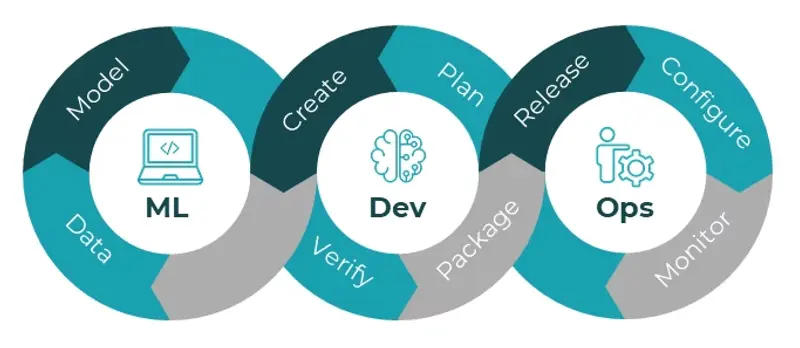
⚠️Common pitfalls:
- Isolated data silos.
- Unrealistic deadlines.
- No executive sponsor.
💬 Lesson
AI implementation is 70% about culture and processes, 30% about code.
3️⃣ Generative AI: Unlocking Creativity and Productivity
Generative AI (GenAI) is where business meets creativity.
It doesn’t just analyse, it creates: text, images, code, and designs that drive content, insights, and engagement.
⚙️ Practical Business Use Cases
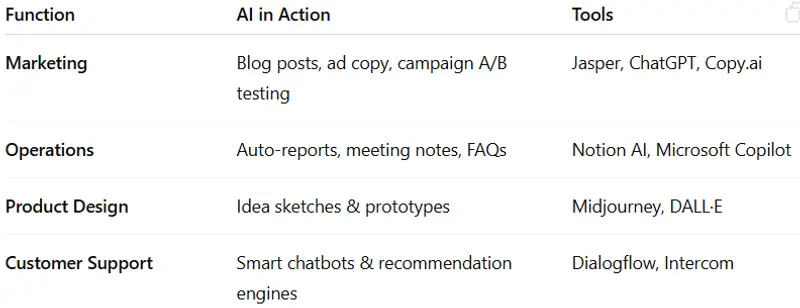
❗Tips for ethical use:
- Verify outputs (avoid hallucinations).
- Respect data licenses.
- Label AI-generated content transparently.
4️⃣ Large Language Models (LLMs): The Brains Behind GenAI
LLMs power most modern business AI tools.They convert language into logic and back again, enabling machines to understand and respond to humans.
🧠 How LLMs Work (Simplified)
Prompt → Encoding → Prediction → Output
🖼️ Visual Placeholder: Step-by-step LLM diagram.

Check out How AI Works in Simple Words guide if you want to learn more =).
💡 Why LLMs Matter for Business
- Automate knowledge work (emails, summaries, contracts).
- Bridge communication between humans and data.
- Adapt instantly across industries.
🪄 Prompt Engineering Essentials

🏅Quick Win: Clear, specific prompts often outperform complex workflows.
Want to learn more prompts? Refer to How to Prompt AI Like a Pro - 10 Tips for More Effective AI Prompting .
5️⃣ AI Agents: From Tools to Teammates
Now we move from passive intelligence to autonomous decision-making.
An AI agent is an intelligent system that can perceive, reason, and act toward a defined goal, often coordinating with humans or other agents.
🔄 The Agent Lifecycle
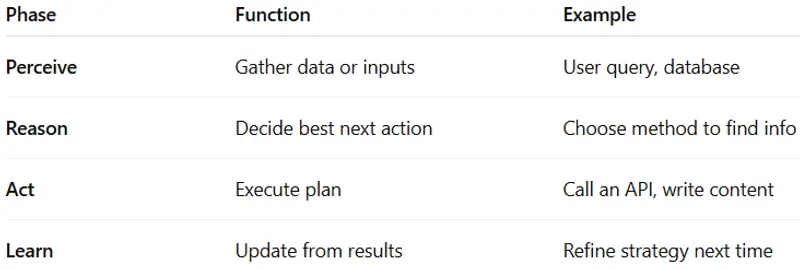
🌟 Use Cases
- 24/7 customer assistants
- Research summarization bots
- Marketing campaign optimizers
- Workflow managers (email, scheduling, analytics)
Key Difference: Traditional tools wait for commands, agents act with intent.
6️⃣ Building Scalable Agentic Systems
Scaling means orchestrating many agents that collaborate and specialise - the digital equivalent of a cross-functional team.
🧩 Design Principles
- Modularity: Each agent owns a task.
- Interoperability: Agents share context via APIs or memory.
- Coordination: Define communication protocols.
- Governance: Maintain oversight, prevent conflicts.
Multi-Agent Collaboration Network
Scaling AI means orchestrating many agents that can reason, act, and communicate. In this example, each agent connects to a shared data hub — ensuring coordination, context awareness, and unified governance across the system.
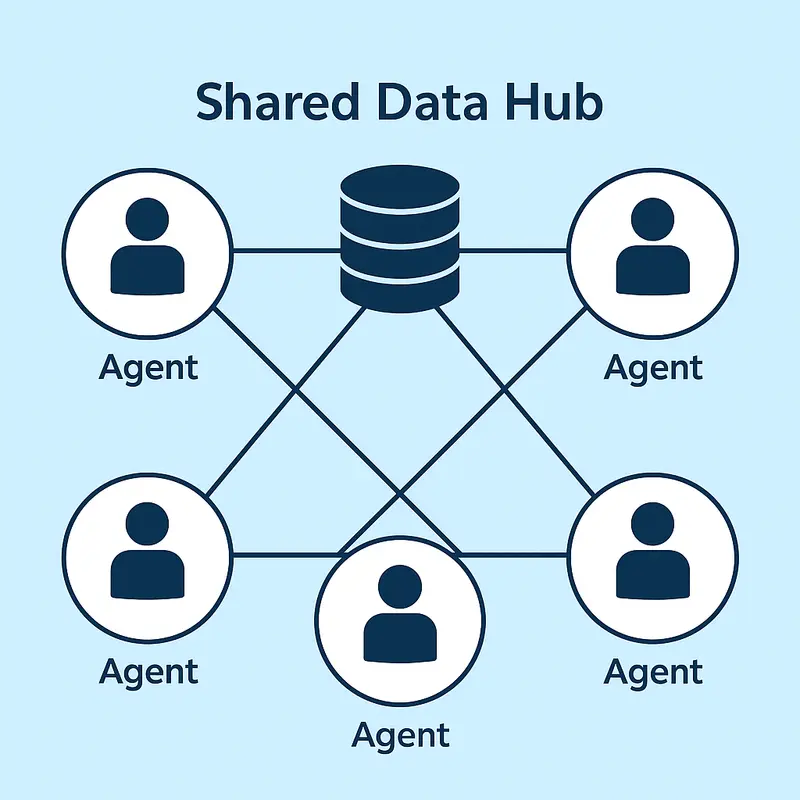
🧰 Key Frameworks
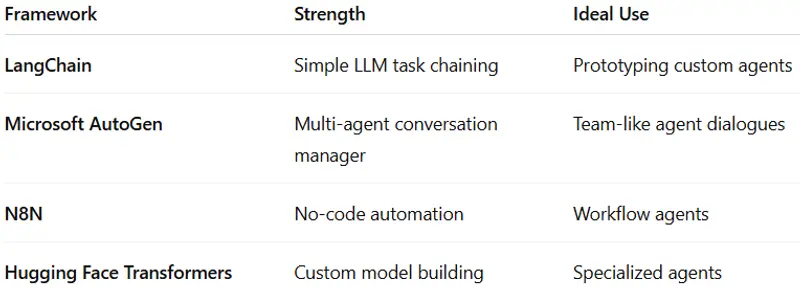
🚧 Scaling Challenges:
- Consistent data access.
- Infrastructure costs (GPU/cloud).
7️⃣ Responsible AI: Building Trust and Transparency
Every DataCamp course underscores one truth: responsible AI is sustainable AI.
⚖️ The Four Ethical Pillars
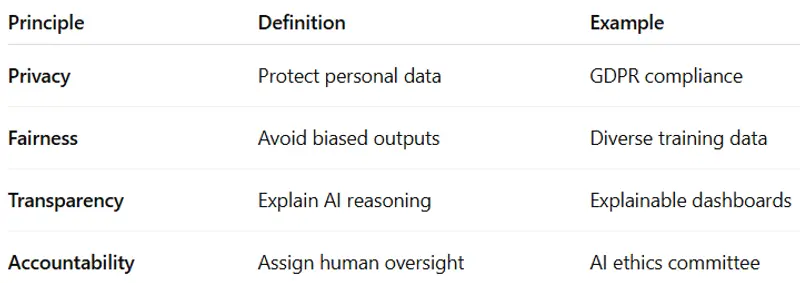
🤝Culture of Trust
- Build AI literacy at all levels.
- Encourage open discussion about limitations.
- Reward safe experimentation and documentation.
8️⃣ Measuring ROI and Continuous Improvement
AI isn’t successful until it shows measurable business value.
📊 ROI Framework
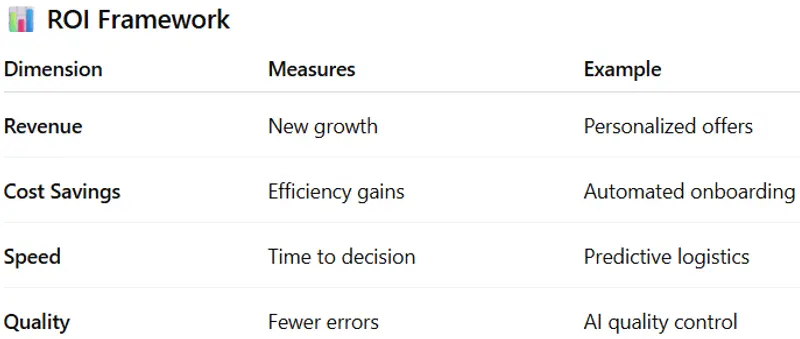
🔁 Continuous Learning Cycle
- Measure → Gather Key Performance Indicators (KPIs).
- Learn → Identify gaps.
- Adapt → Retrain or fine-tune models.
- Scale → Roll out to new functions.
9️⃣ Your Learning Trajectory: The AI Journey
Each concept fits into a single progression.
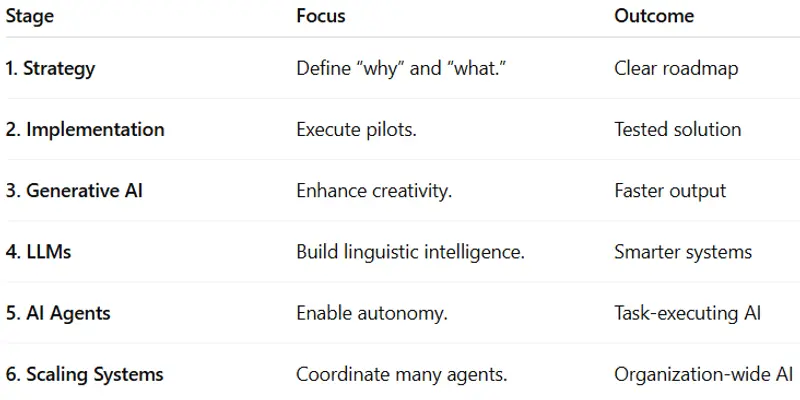
🔮 1️⃣0️⃣ The Future of AI in Business
We’re entering the Agentic Era — AI that collaborates, not just calculates.
Future-ready businesses will:
- Treat data as a living ecosystem.
- Prioritize ethics and transparency.
- Empower hybrid teams of humans + AI agents.
- View AI as a strategic colleague, not just a tool.
🧠 Summary of Fundamentals of AI in Business
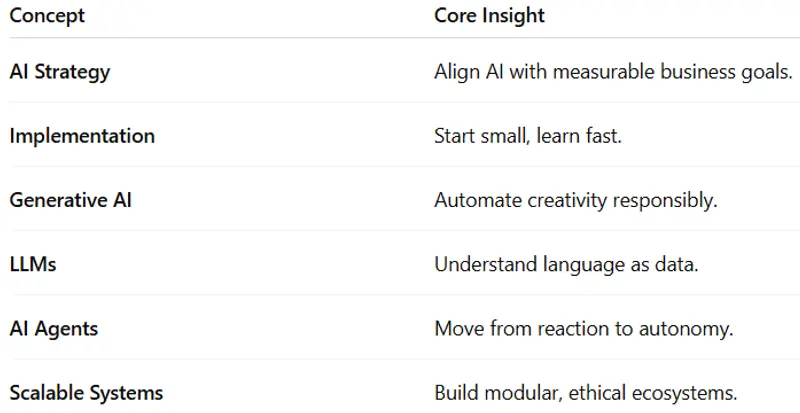
✨ Conclusion
AI isn’t magic, it’s structured intelligence applied with purpose. By understanding the strategy, tools, and responsibilities behind it, you can lead AI initiatives that deliver value and trust.
💬 Next Step: Ready to go from learning to doing? Check out our Best AI Online Courses for Beginners in 2025 to start building your own AI toolkit.
✨ Ready to Take the Next Step?
You’ve got the roadmap - now start applying it. Continue your learning with:
